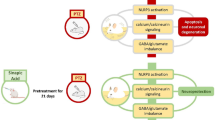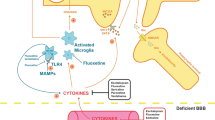Abstract
Rosmarinic acid (RA), a primary constituent of a Chinese herbal medicine, has been shown to have some therapeutic effects in an animal model of depression, but its underlying mechanisms are poorly understood. Sprague–Dawley rats were exposed to chronic unpredictable stress (CUS) for 21 days, and received RA for 14 days from the last week of CUS, then the behavioral changes, hippocampal pERK1/2 and BDNF levels were observed. Rats were further treated with U0126 (an ERK1/2 phosphorylation inhibitor) 30 min before RA treatment to assess the effects of RA and ERK1/2 signaling in depressive-like behavior and hippocampal BDNF levels. In addition, brains of newly born Sprague–Dawley rats were used to harvest and expand hippocampal astrocytes. Cells were exposed to different concentrations of RA (sham, 1, 5, 10, 20, and 40 μg/mL) or U0126 (2 μM as a final concentration) + RA (sham, 1, 5, 10, 20, and 40 μg/mL) for 48 h, and the pERK1/2 and BDNF levels were assessed by western and ELISA assays. RA administration (10 mg/kg daily) reversed depressive-like behaviors in rats exposed to a chronic unpredictable stress paradigm and restored pERK1/2 protein expression and hippocampal brain-derived neurotrophic factor (BDNF). Moreover, in vitro experiments revealed that 20 μg/mL RA increased pERK1/2 and BDNF levels in cultured astrocytes. Interestingly, the effects of RA were inhibited by U0126. RA might be a useful treatment for depression and the changes in ERK1/2 signaling and BDNF levels may play a critical role in the pharmacological action of RA.






Similar content being viewed by others
References
Gibson TB, Jing Y, Smith Carls G, Kim E, Bagalman JE, Burton WN, Tran QV, Pikalov A, Goetzel RZ (2010) Cost burden of treatment resistance in patients with depression. Am J Manag Care 16:370–377
Greeven A, van Balkom AJ, van der Leeden R, Merkelbach JW, van den Heuvel OA, Spinhoven P (2009) Cognitive behavioral therapy versus paroxetine in the treatment of hypochondriasis: an 18-month naturalistic follow-up. J Behav Ther Exp Psychiatry 40:487–496
Swenson JR, O’Connor CM, Barton D, Van Zyl LT, Swedberg K, Forman LM, Gaffney M, Glassman AH (2003) Influence of depression and effect of treatment with sertraline on quality of life after hospitalization for acute coronary syndrome. Am J Cardiol 92:1271–1276
Leucht C, Huhn M, Leucht S (2012) Amitriptyline versus placebo for major depressive disorder. Cochrane Database Syst Rev 12:CD009138
Murata A, Kanbayashi T, Shimizu T, Miura M (2012) Risk factors for drug nonadherence in antidepressant-treated patients and implications of pharmacist adherence instructions for adherence improvement. Patient Prefer Adherence 6:863–869
Berlim MT, Turecki G (2007) Definition, assessment, and staging of treatment-resistant refractory major depression: a review of current concepts and methods. Can J Psychiatry 52:46–54
Brent DA, Birmaher B (2006) Treatment-resistant depression in adolescents: recognition and management. Child Adolesc Psychiatr Clin N Am 15:1015–1034
Ito N, Nagai T, Yabe T, Nunome S, Hanawa T, Yamada H (2006) Antidepressant-like activity of a Kampo (Japanese herbal) medicine, Koso-san (Xiang-Su-San), and its mode of action via the hypothalamic–pituitary–adrenal axis. Phytomedicine 13:658–667
Osakabe N, Yasuda A, Natsume M, Yoshikawa T (2004) Rosmarinic acid inhibits epidermal inflammatory responses: anticarcinogenic effect of Perilla frutescens extract in the murine two-stage skin model. Carcinogenesis 25:549–557
Sanbongi C, Takano H, Osakabe N, Sasa N, Natsume M, Yanagisawa R, Inoue KI, Sadakane K, Ichinose T, Yoshikawa T (2004) Rosmarinic acid in perilla extract inhibits allergic inflammation induced by mite allergen, in a mouse model. Clin Exp Allergy 34:971–977
Takeda H, Tsuji M, Inazu M, Egashira T, Matsumiya T (2002) Rosmarinic acid and caffeic acid produce antidepressive-like effect in the forced swimming test in mice. Eur J Pharmacol 449:261–267
Ito N, Yabe T, Gamo Y, Nagai T, Oikawa T, Yamada H, Hanawa T (2008) Rosmarinic acid from Perillae Herba produces an antidepressant-like effect in mice through cell proliferation in the hippocampus. Biol Pharm Bull 31:1376–1380
Einat H, Yuan P, Gould TD, Li J, Du J, Zhang L, Manji HK, Chen G (2003) The role of the extracellular signal-regulated kinase signaling pathway in mood modulation. J Neurosci 23:7311–7316
Hayley S, Poulter MO, Merali Z, Anisman H (2005) The pathogenesis of clinical depression: stressor- and cytokine-induced alterations of neuroplasticity. Neuroscience 135:659–678
Feng SF, Shi TY, Fan Y, Wang WN, Chen YC, Tan QR (2012) Long-lasting effects of chronic rTMS to treat chronic rodent model of depression. Behav Brain Res 232:245–251
Han BH, Holtzman DM (2000) BDNF protects the neonatal brain from hypoxic-ischemic injury in vivo via the ERK pathway. J Neurosci 20:5775–5781
Murakami S, Imbe H, Morikawa Y, Kubo C, Senba E (2005) Chronic stress, as well as acute stress, reduces BDNF mRNA expression in the rat hippocampus but less robustly. Neurosci Res 53:129–139
Schmidt HD, Duman RS (2010) Peripheral BDNF produces antidepressant-like effects in cellular and behavioral models. Neuropsychopharmacology 35:2378–2391
Molteni R, Calabrese F, Cattaneo A, Mancini M, Gennarelli M, Racagni G, Riva MA (2009) Acute stress responsiveness of the neurotrophin BDNF in the rat hippocampus is modulated by chronic treatment with the antidepressant duloxetine. Neuropsychopharmacology 34:1523–1532
Gao LP, Wei HL, Zhao HS, Xiao SY, Zheng RL (2005) Antiapoptotic and antioxidant effects of rosmarinic acid in astrocytes. Pharmazie 60:62–65
Wei R, Lin CM, Tu YY (2010) Strain-specific BDNF expression of rat primary astrocytes. J Neuroimmunol 220:90–98
Miklic S, Juric DM, Carman-Krzan M (2004) Differences in the regulation of BDNF and NGF synthesis in cultured neonatal rat astrocytes. Int J Dev Neurosci 22:119–130
Sironi L, Banfi C, Brioschi M, Gelosa P, Guerrini U, Nobili E, Gianella A, Paoletti R, Tremoli E, Cimino M (2006) Activation of NF-kB and ERK1/2 after permanent focal ischemia is abolished by simvastatin treatment. Neurobiol Dis 22:445–451
Du J, Wang Q, Hu B, Peng Z, Zhao Y, Ma L, Xiong L, Lu Y, Zhu X, Chen S (2010) Involvement of ERK 1/2 activation in electroacupuncture pretreatment via cannabinoid CB1 receptor in rats. Brain Res 1360:1–7
Koo JW, Duman RS (2008) IL-1beta is an essential mediator of the antineurogenic and anhedonic effects of stress. Proc Natl Acad Sci USA 105:751–756
Slattery DA, Cryan JF (2012) Using the rat forced swim test to assess antidepressant-like activity in rodents. Nat Protoc 7:1009–1014
Wang HN, Peng Y, Tan QR, Wang HH, Chen YC, Zhang RG, Wang ZZ, Guo L, Liu Y, Zhang ZJ (2009) Free and Easy Wanderer Plus (FEWP), a polyherbal preparation, ameliorates PTSD-like behavior and cognitive impairments in stressed rats. Prog Neuropsychopharmacol Biol Psychiatry 33:1458–1463
Wang HN, Peng Y, Tan QR, Chen YC, Zhang RG, Qiao YT, Wang HH, Liu L, Kuang F, Wang BR, Zhang ZJ (2010) Quetiapine ameliorates anxiety-like behavior and cognitive impairments in stressed rats: implications for the treatment of posttraumatic stress disorder. Physiol Res 59:263–271
Zhu H, Chen MF, Yu WJ, Wang WJ, Li F, Liu WC, Wo Y, Xia R, Ding WL (2012) Time-dependent changes in BDNF expression of pentylenetetrazole-induced hippocampal astrocytes in vitro. Brain Res 1439:1–6
Vostalova J, Zdarilova A, Svobodova A (2010) Prunella vulgaris extract and rosmarinic acid prevent UVB-induced DNA damage and oxidative stress in HaCaT keratinocytes. Arch Dermatol Res 302:171–181
Osakabe N, Takano H, Sanbongi C, Yasuda A, Yanagisawa R, Inoue K, Yoshikawa T (2004) Anti-inflammatory and anti-allergic effect of rosmarinic acid (RA); inhibition of seasonal allergic rhinoconjunctivitis (SAR) and its mechanism. BioFactors 21:127–131
Banasr M, Valentine GW, Li XY, Gourley SL, Taylor JR, Duman RS (2007) Chronic unpredictable stress decreases cell proliferation in the cerebral cortex of the adult rat. Biol Psychiatry 62:496–504
Potter GG, Wagner HR, Burke JR, Plassman BL, Welsh-Bohmer KA, Steffens DC (2013) Neuropsychological predictors of dementia in late-life major depressive disorder. Am J Geriatr Psychiatry 21:297–306
Deltheil T, Guiard BP, Cerdan J, David DJ, Tanaka KF, Reperant C, Guilloux JP, Coudore F, Hen R, Gardier AM (2008) Behavioral and serotonergic consequences of decreasing or increasing hippocampus brain-derived neurotrophic factor protein levels in mice. Neuropharmacology 55:1006–1014
Czubak A, Nowakowska E, Kus K, Burda K, Metelska J, Baer-Dubowska W, Cichocki M (2009) Influences of chronic venlafaxine, olanzapine and nicotine on the hippocampal and cortical concentrations of brain-derived neurotrophic factor (BDNF). Pharmacol Rep 61:1017–1023
Peng Q, Masuda N, Jiang M, Li Q, Zhao M, Ross CA, Duan W (2008) The antidepressant sertraline improves the phenotype, promotes neurogenesis and increases BDNF levels in the R6/2 Huntington’s disease mouse model. Exp Neurol 210:154–163
Shirayama Y, Chen AC, Nakagawa S, Russell DS, Duman RS (2002) Brain-derived neurotrophic factor produces antidepressant effects in behavioral models of depression. J Neurosci 22:3251–3261
Paizanis E, Renoir T, Lelievre V, Saurini F, Melfort M, Gabriel C, Barden N, Mocaer E, Hamon M, Lanfumey L (2010) Behavioural and neuroplastic effects of the new-generation antidepressant agomelatine compared to fluoxetine in glucocorticoid receptor-impaired mice. Int J Neuropsychopharmacol 13:759–774
Massa SM, Yang T, Xie Y, Shi J, Bilgen M, Joyce JN, Nehama D, Rajadas J, Longo FM (2010) Small molecule BDNF mimetics activate TrkB signaling and prevent neuronal degeneration in rodents. J Clin Invest 120:1774–1785
Duric V, Banasr M, Licznerski P, Schmidt HD, Stockmeier CA, Simen AA, Newton SS, Duman RS (2010) A negative regulator of MAP kinase causes depressive behavior. Nat Med 16:1328–1332
Fellin T (2009) Communication between neurons and astrocytes: relevance to the modulation of synaptic and network activity. J Neurochem 108:533–544
Conti B, Maier R, Barr AM, Morale MC, Lu X, Sanna PP, Bilbe G, Hoyer D, Bartfai T (2007) Region-specific transcriptional changes following the three antidepressant treatments electro convulsive therapy, sleep deprivation and fluoxetine. Mol Psychiatry 12:167–189
Sillaber I, Panhuysen M, Henniger MS, Ohl F, Kuhne C, Putz B, Pohl T, Deussing JM, Paez-Pereda M, Holsboer F (2008) Profiling of behavioral changes and hippocampal gene expression in mice chronically treated with the SSRI paroxetine. Psychopharmacology 200:557–572
Di Benedetto B, Kuhn R, Nothdurfter C, Rein T, Wurst W, Rupprecht R (2012) N-desalkylquetiapine activates ERK1/2 to induce GDNF release in C6 glioma cells: a putative cellular mechanism for quetiapine as antidepressant. Neuropharmacology 62:209–216
Li B, Zhang S, Li M, Hertz L, Peng L (2009) Chronic treatment of astrocytes with therapeutically relevant fluoxetine concentrations enhances cPLA2 expression secondary to 5-HT2B-induced, transactivation-mediated ERK1/2 phosphorylation. Psychopharmacology 207:1–12
Allaman I, Fiumelli H, Magistretti PJ, Martin JL (2011) Fluoxetine regulates the expression of neurotrophic/growth factors and glucose metabolism in astrocytes. Psychopharmacology 216:75–84
Hisaoka K, Takebayashi M, Tsuchioka M, Maeda N, Nakata Y, Yamawaki S (2007) Antidepressants increase glial cell line-derived neurotrophic factor production through monoamine-independent activation of protein tyrosine kinase and extracellular signal-regulated kinase in glial cells. J Pharmacol Exp Ther 321:148–157
Chkhartishvili E, Maglakelidze N, Babilodze M, Chijavadze E, Nachkebia N (2011) Changes of open field behavior in animal model of depression. Georgian Med News 11:107–112
Dong Z, Bai Y, Wu X, Li H, Gong B, Howland JG, Huang Y, He W, Li T, Wang YT (2013) Hippocampal long-term depression mediates spatial reversal learning in the Morris water maze. Neuropharmacology 64:65–73
Acknowledgments
This work was supported by the National Natural Science Foundation of China (81201054 and 81201041).
Author information
Authors and Affiliations
Corresponding author
Additional information
Xiang Jin and Peng Liu contributed equally to this work.
Rights and permissions
About this article
Cite this article
Jin, X., Liu, P., Yang, F. et al. Rosmarinic Acid Ameliorates Depressive-Like Behaviors in a Rat Model of CUS and Up-Regulates BDNF Levels in the Hippocampus and Hippocampal-Derived Astrocytes. Neurochem Res 38, 1828–1837 (2013). https://doi.org/10.1007/s11064-013-1088-y
Received:
Revised:
Accepted:
Published:
Issue Date:
DOI: https://doi.org/10.1007/s11064-013-1088-y




